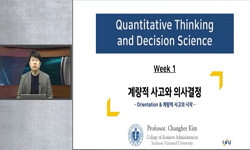6차 산업화는 농업·농촌의 부가가치를 증대하고 지속가능한 발전을 도모하기 위해 운용되고 있는 농정 패러다임이다. 그러나 2013년 처음 시작된 6차 산업화 정책은 4차 산업혁명이 진행중 ...
http://chineseinput.net/에서 pinyin(병음)방식으로 중국어를 변환할 수 있습니다.
변환된 중국어를 복사하여 사용하시면 됩니다.
- 中文 을 입력하시려면 zhongwen을 입력하시고 space를누르시면됩니다.
- 北京 을 입력하시려면 beijing을 입력하시고 space를 누르시면 됩니다.

6차 산업화 정책 발전을 위한 의사결정 우선순위 분석 : SWOT-AHP 방법론을 적용하여 = Analysis of Decision Making Priorities for the Development of the 6<sup>th</sup> Industrialization Policy : Applying the SWOT-AHP Methodology
한글로보기https://www.riss.kr/link?id=A107354795
- 저자
- 발행기관
- 학술지명
- 권호사항
-
발행연도
2021
-
작성언어
-
- 주제어
-
등재정보
KCI등재
-
자료형태
학술저널
-
수록면
223-261(39쪽)
- 제공처
- 소장기관
-
0
상세조회 -
0
다운로드
부가정보
국문 초록 (Abstract)
6차 산업화는 농업·농촌의 부가가치를 증대하고 지속가능한 발전을 도모하기 위해 운용되고 있는 농정 패러다임이다. 그러나 2013년 처음 시작된 6차 산업화 정책은 4차 산업혁명이 진행중 임에도 평면적인 운용으로 인해 한계를 보이고 있다. 이에 본 연구는 6차 산업화 정책의 의사결정 우선순위를 도출하기 위해 SWOT 요인을 계층화하고 전문가 대상 AHP 분석을 실시하여 직관에 의존하던 SWOT 요인들을 계량화하여 개별요인들의 상대적인 중요도를 파악할 수 있도록 하였다. 분석결과 6차 산업화는 위협(T)요인이 0.396의 가중치로 가장 높게 나타났고, 이어서 기회(O) 0.312, 약점(W) 0.217, 강점(S) 0.198 순으로 도출되었다. 전체 SWOT의 세부중요도 순위는 위협(T)요인인 ‘정보부족 및 비대칭’이 0.424로 가장 높았고, 동일요소 그룹의 ‘정책변동성’이 0.155로 나타났으며, 기회(O)요인의 ‘4차 산업혁명’과 ‘6차 산업화 인지도 증대’ 순으로 나타났다. 본 연구에서는 최종 우선순위 도출을 위한 2단계 AHP 분석을 하였다. 이를 위해, < SO전략 >, < WO전략 >, < ST전략 >, < WT전략 >을 도출하고, 2단계 AHP 분석을 통해 각 부문별 최종 우선순위를 선정하였다. SWOT-AHP 분석결과 S<sub>2</sub>T<sub>3</sub> “농업정보 플랫폼 구축”이 가장 높은 가중치로 나타났고, 이어서 S<sub>2</sub>O<sub>3</sub> (기술확산형 정부지원 정책) > W<sub>1</sub>T<sub>3</sub> (스마트 농업 고도화) > W<sub>1</sub>O<sub>3</sub>(4차 산업혁명기술을 적용한 농업구조 문제해결) 순으로 도출되었다. 이상의 분석결과는 선험적으로 인식하고 있는 농업부문의 현안문제를 계량화한 분석기법을 활용하여 밝힘으로써 4차 산업혁명 시대에 적합한 농업정책을 추진하는데 의미있는 시사점을 제공한다는 점에서 의미가 있다.
다국어 초록 (Multilingual Abstract)
The 6<sup>th</sup> industrialization is an agricultural paradigm that is being operated to increase the added value of agriculture and farming villages and promote sustainable development. However the 6th industrialization policy what is b...
The 6<sup>th</sup> industrialization is an agricultural paradigm that is being operated to increase the added value of agriculture and farming villages and promote sustainable development. However the 6th industrialization policy what is begun in 2013 is limited by formal and rough operation even though the 4th industrial revolution is underway. Therefore, this study stratified the SWOT factors to find the implications of the 6th industrialization development, and conducted AHP analysis for experts to quantify the SWOT factors that depended on intuition so that the relative importance of individual factors could be analyzed. According to the analysis, the 6th industrialization factor is the Threat(T) what it is the highest with a weight of 0.396, and Opportunity(O) 0.312, Weakness(W) 0.217, Strength(S) 0.198. The overall SWOT detail ranking is a Threat(T) factor “information shortage and asymmetry” was the highest at 0.424, the “policy volatility” of the same factor group was the second at 0.155, followed by the “4th industrial revolution” of the Opportunity(O) factors and the 6th industrialization awareness increase. As a result of SWOT-AHP analysis to establish 6th industrialization development strategy in the 4th Industrial Revolution era, SSO Strategy derived < S<sub>2</sub>O<sub>3</sub> >: ‘Technology Diffusion Government Support Policy’, < W<sub>1</sub>O<sub>3</sub> >: ‘Problem Solving Agricultural Structure by Applying Fourth Industrial Revolution Technology’, and < S<sub>2</sub>T<sub>3</sub> >: ‘Establishment Agricultural Information Platform’, < W<sub>1</sub>T<sub>3</sub> >: ‘Advancement of Smart Agriculture’. In this study, A two-stage AHP analysis was conducted to determine the final priority. As a result of the analysis, S<sub>2</sub>T<sub>3</sub> ‘establishment of agricultural information platform’ was the highest weight, followed by S<sub>2</sub>O<sub>3</sub>(Technology diffusion type government support policy) > W<sub>1</sub>T<sub>3</sub>(Smart agriculture advancement) > W<sub>1</sub>O<sub>3</sub> (Agricultural structure problem solution applying 4th industrial revolution technology) was derived. The above results are meaningful in that they provide effective implications for promoting agricultural policies suitable for the 4th Industrial Revolution era by quantifying the pending issues in the agricultural sector, which are recognized previously.
동일학술지(권/호) 다른 논문
-
지방공기업의 조직개편에 영향을 미치는 요인에 관한 연구
- 한국지방행정연구원
- 이재연 ( Lee Jaeyoun )
- 2021
- KCI등재
-
- 한국지방행정연구원
- 이재용 ( Lee Jaeyong )
- 2021
- KCI등재
-
IPA를 활용한 정부 규제혁신정책의 성과분석 : 규제샌드박스를 중심으로
- 한국지방행정연구원
- 배영임 ( Young Im Bae )
- 2021
- KCI등재
-
- 한국지방행정연구원
- 한재명 ( Jae Myung Han )
- 2021
- KCI등재




 KCI
KCI KISS
KISS







